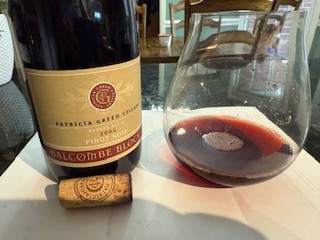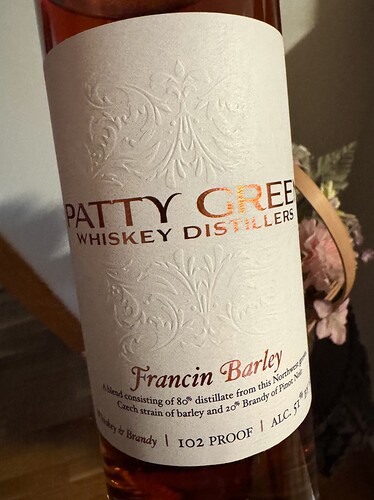This also feels right. I remember when the intial rumblings about the quality of the 2007 vintage began I was perplexed. While it was occurring we thought it was a very good vintage and as the wines developed in barrel we believed it was an excellent vintage that followed 2005 (amazing) and 2006 (excellent and popular for us but a vintage with a lot of overripe/wrought wines in the valley) very nicely. As discussed in its own thread here it’s turned out to be a vintage that has done quite well over time.
Thanks Jim. I’m not as good at picking out whole cluster influence as others in my tasting group. Still trying to learn and gets harder as the wine ages. (at least for me)
I wouldn’t either worry about a perceived lack of ability to pick out what are thought to be whole cluster characteristics or about even making it some goal to be able to do so on a regular basis. The most experienced reviewers in the world can’t do it on the regular. I’ve seen it over and over again. It’s because there really isn’t a specific thing or set of things that necessarily define wines with whole cluster fermentations.
We just racked a large set of 2024 Pinots. There are 2 that are 100% whole cluster, there’s one that is basically that as well. There are wines in between and a couple that are fully destemmed. One would be hard pressed to go through and figure out what was what. Across the 100% whole cluster wines are an array of aromatic and textural qualities but no single theme to them at all.
A (former?) board person, Ken Z (I think) had a stated dislike for whole cluster wines. There are certainly wines that are done with whole clusters that have an identifiable green/weirdly tannic nature to them. That’s just poor execution or bad taste on the winery’s part. But it has given folks the notion that that is what they should be looking for. It’s sort of the same thing Sauvignon Blancs with high levels of pyrazines have, because of their large volumes, have created this notion in the general public about what Sauvignon Blanc tastes like when, in fact, it’s only what poorly crafted Sauvignon Blanc tastes like.
I couldn’t identify all my wines blind and no one has more knowledge of their history and experience with them both with any one vintage and with the breadth of vintages that would help define them. It’s an impossible task.
I think that was Richard Jennings (specifically for Pinot Noir). Ken embraces whole cluster, especially during early punch downs.
-Al
What kind of berserker would I be if I didn’t have some sort of impossible wine goal? ![]()
I’ve never had an issue with what I thought was whole cluster with oregon wines (or Dujac for that matter), but I strongly dislike the herbal green quality in the older Rhys wines. I always thought it was the whole cluster…but maybe I just don’t like SCM Pinot?
Yeah–I drink with some pretty good tasters/drinkers, and I/we are laughably bad at this. I’ve decided it’s a waste of time to speculate about. It’s like me guessing and asking what the fermentation temperature was.
If you are basing your thinking on getting green stemmy stuff, or weird tannins, you are going to be wrong from the get-go, or just drinking a poorly made wine, as Jim points out. The only thing that has been a bit useful for me is finding a white pepper-like note in some whole cluster wines, but when it rises to this level, it’s generally in a wine that you already know is whole cluster–like Lambrays. So really only useful if you are tasting blind.
Or David Z(ilber?) with the duck avatar?
There may be more than one, I think David was particularly not a fan of Rhones with a lot of WC (eg, Texier). Here is a thread with Richard’s thoughts on whole cluster in Pinot Noir:
That’s the one I remember.
Opened a ‘22 Ghost Barn Block to see how many ‘23 I stuff into the cellar. The answer appears to be “many”…
Pulled cork, poured out a small taster, and then left both for several hours because I got distracted. But upon tasting 3 hours later, this is a wine of great structure; complete guessing (as I didn’t try it early) but I imagine it would show up out of the bottle as “closed down” based on 3 hour evolution — bright red fruit, black tea, spice. Lengthy finish with beautiful presence on the back of palate.
It’s almost if you, unknowingly, were convinced to write this up right now. You don’t even know why but in a few days you will! And, the ‘23 Ghost Barn is outrageous.
2006 Balcombe Block 1B, enjoyed over two nights and it continues to punch well above its weight. Still a lot of red fruit present but very smooth and silky. Definitely has more life left in it at this stage. Also had the 2006 Etzel Block last week. I found the Etzel to be a bit more muted and softer than the Balcombe, but very good in its own right. Overall, I’d say the Balcombe was in a better place, but you couldn’t go wrong with either!

Nice. 2006s still continue to probably outkick their perceived coverage given the warmth, especially right before harvest of the vintage. Glad they were both still providing levels of enjoyment.
First sip of the Patty Green Distillers offerings. It’s lovely. Will be even better on a cool fall evening rather than a sweltering summer night.
That is a special bottle. Like the best snickerdoodle ever.
I like that reference. The flavor profile reminds me of my favorite Bourbon, Elmer T. Lee.
@Jim_Anderson: #HoseGate, #WhereMyHoseAt
Yellow card me. No idea what this means.
I believe Dan is referencing the mix up that resulted in the “special” 2024 Reserve bottling. ![]()
![]()
We cracked a 2016 Estate Old Vine last night and it was straight down the strike zone. I thought it was quite a bit better than a bottle two years ago. I guess around ten years is when the magic starts. Our friends really loved it and also happen to be Whiskey fans. I discreetly pointed out the URL link on the back of the bottle.
